Five bike fitting fads that hold
you back
How to identify and avoid them
Cycling is a sport of tradition.
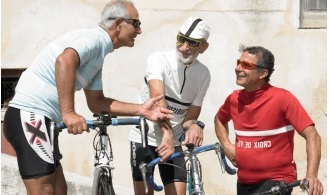 And
with tradition comes baggage: the accumulated, common peloton
knowledge that gets passed on and on... And
with tradition comes baggage: the accumulated, common peloton
knowledge that gets passed on and on...
While
tradition has a place and can protect us from trendy and often
dangerous fads, it also holds us back, refuting and often
attempting to demonize beneficial advances.
In this article we'll uncover the 5 most
critical fads that can reduce your performance or even hurt you.
Cycling is also a sport of technology
- more so than tradition.
Fortunately for us, much research and effort is devoted by
Sports Medicine professionals, bicycle/components manufacturers
and cycling industry professionals with the goal of finding more and better
performance.
Sometimes, the results of these efforts are
so revolutionary and advanced that they cause a huge
leap forward in the entire industry, leaving behind an obsolete
knowledge base and spurring a whole new mentality -and even new
industry segments.
|
This has been especially the case with bike fitting,
where the advances in the last few years have completely
shattered the knowledge of everything we thought we knew about
the relationship between a human and a bicycle. Modern bike
fitting broke through performance barriers once thought
impossible to pass.
But for every leap forward, there is a
baggage of accumulated knowledge (now obsolete), experience
(in need of updating) and groups of
nay-sayers that tend to persist and hold back progress.
In cycling that baggage is the all-pervasive
old-school common knowledge of how a cyclist
should be positioned on a bike. And because this is a sport of
tradition, while fads come and go, old-school bike fitting
misinformation is
still out there, permeating everyday communications, being
repeated over and over, passing down from cyclist to
cyclist and creating false illusions of competence. |
|

|
What happens when technology makes a leap
Think
what the creation of low-voltage, miniaturized strain
gauges has done to jump start a whole new industry
segment: power meters. And look at how it completely
changed the way we train. It created a whole new
knowledge of training methodology - while spurring a new
breed of coaches and making coaching a multi-million
dollars industry.
Bike Fitting has
gone through a similar, but more technologically
significant leap with Retül 3D motion capture
technology. It just didn't change the methodology of
bike fitting; it revealed new, deeply hidden secrets of
human bio-dynamics and bio-mechanics that created a
whole new bike
fitting paradigm for performance.
|
|
In this article, we address the most common
old-school fads. The ones that not only are the most common,
but also hold you back the most.
You know them by heart: the
ones you think are the tenets, the fundamentals of biking because they seem to be repeated by everyone.
Young or old, everyone mindlessly recites these fads as if
they were commandments with absolute, unquestionable truth. And
so, you have come to believe them.
Modern bike fitting science has proven these
fads
are not to be trusted. You are better off updating your book of
common cycling knowledge if you are to move forward.
Let's look at these old-school fads. Lets
find how they came to be, talk about how
they became obsolete and why they actually hold
back your performance.
-
Low back for aero
-
Aero knees
-
Cleat position
-
Plum line
-
Mountain bikers don't
need fitting
|
|
1) LOW BACK FOR AERO

Fad: You must
ride low down to be aero and go faster
Everyone wants to go faster. So this fad lodged itself
into the imagination of every cyclist: cheating the wind
by reclining one's body down and forward on the
handlebar, stretching out long and low.
The practice: Install a long
stem, slam it. Get low. Lower.
The trouble: a rider
that is stretched out and low is loosing power, has
trouble breathing and is more prone to injuries in the
hip, back and knee area.
The issue: Thanks to
tools like Retül 3D motion capture and Racemate
Computrainer power meter, wind tunnel testing and sports
medicine studies, we have been able to
conclusively prove that a low back clearly hurts human
performance and doesn't improve aero. Power
significantly drops after a certain back angle while the aero advantage of
the more tucked-in
position remains the same or gets worse.
From a biomechanical point of view, pedaling when the
back is too low, creates problems at the lower back and
hips.
Lower back: a stretched out position
locks the abs and lower back in position
because the handlebar reach is too long. Pedaling is an
up and down motion. It requires a fluid interaction
between the upper and lower body. A locked back negates
this interaction and robs you of power and comfort.
Hips: when the back is too low, the hip
are too compressed at the top of the pedal stroke,
robbing a cyclist of power in most parts of the pedal
stroke. Clearing the top most part of the
pedal stroke becomes troublesome and
reduces massively the ability to generate power.
From a purely aerodynamic point of
view, it was also proven that a flat back creates
more drag than a properly curved one. This is
related to the issue of extraction of stagnating
flows. A flat back causes the air flow to stall
immediately behind the helmet, in the back and neck region and
also in the abs/pelvis/quad area. This causes an
increase in drag as compared to being more upright.
Tell tale signs: locked
elbows, stretched out arms, back is too flat, quads hit
stomach.
The consequences: pain
in hands, lower back, shoulder and neck. The legs hit the stomach and the hip flexor are sore
after riding. Knees often feel sore too. Loss of power,
loss of comfort and loss of aero efficiency
|
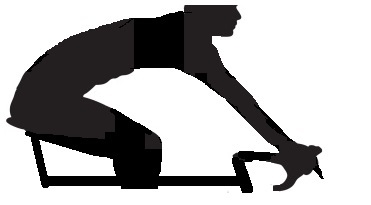
A poorly position cyclist.

The Aerodynamics of the over-extended rider. Stalled
flow (the green/red eddies) over the back, neck and in
the pelvic/quad area cause high pressure. The areas of
high pressure fight each other and push flow away. This
reverses flow direction at the pelvic and quad area and
interferes with oncoming flow: increased drag. |

THE FIX: Depending on the application (road,
Tri, MTB, racing, recreational riding long distance, etc.) and on the
current situation of the rider (flexibility, injuries,
pain, etc.), the position of a rider is adjusted so that
the handlebar reach and stack are supportive of a
comfortable position while improving both power
and aerodynamics. A bend at the elbows is induced by
selecting the correct length stem and height (rather
than by forcing oneself in that position) and an
optimized back angle is induced, so drag is reduced.
From a biomechanical point of view, a properly
positioned rider is able to engage the upper body
and abs to pedal in harmony with the lower body.
This helps in generating more power as it unlocks the
ability to use the arms and the core in assisting the legs
in the down stroke (much like when climbing and pulling
hard on the handlebar).
By inducing a fluid relationship at the upper/lower
back point, the typical strain that causes pain in
the lower back is improved. This also helps
taking pressure off the hands and shoulders/neck.
From an aerodynamic point of view, a higher back is
also better (up to a point).
Why a higher position is more aero than a lower?
Doesn't it sound counter intuitive?
A good aerodynamicist knows that creating a speed
differential in the air between the upper part of the
body (the back/shoulder/neck) and the lower part of the
body (the torso/pelvis/quad) is vital in enabling the air flow to
be extracted from the typical points of stagnating air.
This is done by creating pressure differentials much
like in an airplane wing: the upper part must be a
longer path.
When done right, the air above
the back is induced into a lower pressure and sucks out
the air below the abs/quad/pelvis through the underbelly
of the saddle to form a uniform and clean airflow
- reducing drag. This can be done only by
rotating up the back and creating a curvature at the
spine -and it can be done so that it's biomechanically
and ergonomically much more effective.
The improvement: pain
is averted in lower back, hands, neck/shoulders, hips,
knees. Power is significantly improved. Aero is more
efficient. Win-Win. |
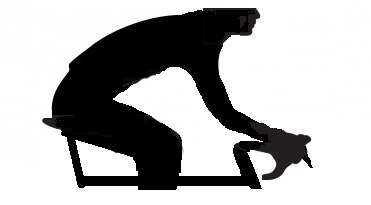
A properly positioned cyclist
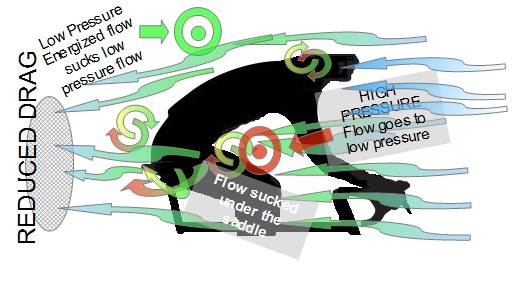
The Aerodynamics of the fit rider. Air flow over the
back is smooth and fast, creating a low pressure. The
high pressure in the pelvic/quad area due to stalled
flow (the green/red eddies) causes the stagnant air to
be sucked below the saddle: reduced drag.
|
2) AERO KNEES

Fad: You must
ride with your knees close to the top tube
to be aero
This is a particularly damaging
fad. Someone in the old days decided that keeping the
knees close to the top tube reduced the drag. It spread
like wildfire. Of course it did. Everything that's
supposed to make you faster must be good.
The practice: You are told by
countless people in the peloton to hold your knees tight
to the tube. You see all the fast, skinny guys doing it.
It must be right.
The trouble: forcing
oneself to keep the knees tight to the top tube creates
an unnatural position that puts tremendous strain on
your knees, ankles and hips. It also can cause hot spots
under your feet.
The issue: pushing the
knees inward causes a mis-alignement between your
foot-knee-hip alignment. When pedaling with the knee out
of the plane created by the femur-tibia, the knee tracks
outside the foot.
Whenever the knee doesn't track aligned with the
foot, tremendous strain is put on the IT band, ACL/MCL,
ankle's peroneal tendon, and hip flexors/abductors. The
forces are directly related to the intensity and the
RPM: the harder you go, the more likely the damage.
Ironically, it has been well-documented in wind
tunnel testing that there is no aerodynamic
advantage. Actually, the opposite. Keeping the
knees in increases induced drag by as much as 15%.
Tell tale signs: knees
close to the top tube, forming an angle between the
femur and the tibia and twisting the ankle.
The consequences: damage
can occur in the knees, IT band, ACL, peroneal tendon in
the ankle and hip flexors. Most commonly, IT band
inflammation is too severe to ride comfortably. In some
severe cases, some damage can be permanent, especially
in the knee patella area. Loss of power.
|
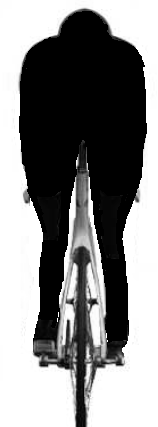
A cyclist keeping the knees too close to the top tube
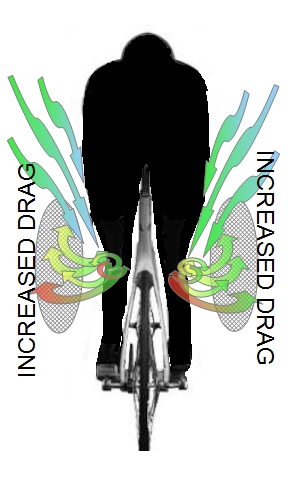
The Aerodynamics of the knees to close to the top
tube. The incoming air is first pulled in at the hips
and quads and then pushed out by the knees. This creates
a stalled
flow (the green/red eddies) near the knee. It also
causes the air flow to turn outwards and
interfere with oncoming flow: increased drag. |

THE FIX: Stop it! Just
stop doing this to yourself. There is no
aerodynamic advantage but there a wealth of injuries to
be found in engaging in this behavior.
The IT band is
a severe risk, and so is the knee. In 2 hours you do
over 10k pedal revolutions at 90 RPM. Every one of those
revolutions aggravates your knee and IT band a little
more.
From an aerodynamic point of view, the drag
created by keeping your knees close to the top tube is
actually more than with your knees correctly
aligned to your feet.
It's counter-intuitive to most of us. We experience
drag by the simple changes in the shape of an object. A
flat hand against the wind is more aero than a
perpendicular palm. This is called form drag.
Common experience tells you that a sharp object is more
aero than a blunt. But that's where you go wrong.
Drag is more directly related to how
efficiently you manage the air flow rather than the
sharpness of an object. A good example is a golf
ball. You would think that the dimples in the ball
should make it less aero. But in reality, they make it
more aero and faster. That's because it has less
induced drag.
Induced drag is the invisible drag that
is responsible for much of the resistance objects
encounter when in an a flow. It has to do with the
way the flow goes past a shape and separates from the
object. The more separation, the more drag.
Think of a wake behind a boat. That's induced drag; it
slows down the boat. A golf ball uses the dimples to
force the flow not to separate and therefore can fly
further.
Knees pointed to the inside create a shape that
pushes the air away at an angle from a cyclists (same as
the elbows). Air flow doesn't like making turns around
angles. So when pushed outward by the knees angled to
cradle the top tube, instead of following the shape of
the leg and aligning to the direction of motion, air
flow separates at the quad/knee, creating induced drag.
Lots of it. One study put it at 15% more drag.
So why doing that to yourself?
The improvement: less
knee/IT band, ankle/foot, hip pain. More aero. More
power |
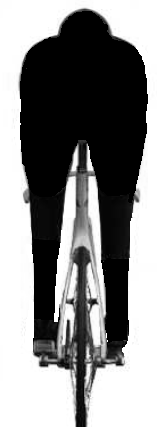
A cyclist pedaling with properly aligned knees.
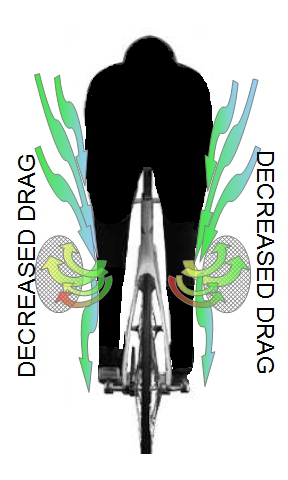
The Aerodynamics of the knees aligned to the top
tube. The incoming air is pushed out by the knees
significantly less. This reduces or prevents the stalled
flow near the knee. It also keeps the air flow aligned
with the body so it doesn't interfere with oncoming flow:
decreased drag. |
3) CLEAT POSITION

Fad: You must
lock your cleats straight
This fad established
itself as a solution to improve efficiency in the pedal
stroke since the inception of the clipless pedal
in the early 80s. It stuck, in the face of the
experiential and medical knowledge of the damage it
does.
The practice: you are told
your toes point out/in. You are told to buy fixed cleats
to align your toe straight because it's more efficient.
You are told foot floating on the pedal is bad.
The trouble:
floating is nature's way to deal with revolution.
Because the foot reverses direction during the pedal
stroke and engages different muscles that are not
symmetrically attached to the bones, float naturally
occurs. Every cyclist floats 2 deg or more, no matter
how technical the pedal stroke is. The foot moves
slightly from Left to Right during the pedal stroke,
especially at the top and the bottom of the pedal stroke
where the foot reverses direction. Cleats that allow 6-8+
degrees of float are ideal, and should be used by all
cyclists. The trouble is that
most manufacturers sell new pedals with reduced float
cleats, and many "experts" at bike shops steer
customers to low/no float cleats, further aggravating this problem.
The issue: Some people
have a natural tendency to point their toes out or in.
It's nature's way to deal with their particular
biomechanical configuration of bones and muscle
attachments. It's not good or bad (in most cases, but for a
few people it may point to an underlying medical issues).
It is what it is. And it must be protected, not
corrected.
From a strictly mechanical point of view, not
pedaling with your toes perfectly aligned to the
direction of pedal is slightly less efficient. That's where the
fad originated from: a well-intentioned mechanical
engineer studying pedaling mechanics. But humans
are not machines, made of push-rods and bolts.
Human movement can't be reduced to bones = metal rods,
joints = eyelets and bolts. This would imply that pedaling motion
is strictly in 2 Dimentions.
Humans have posture and gait habits. Humans move in
3D, even when performing a task that is mostly activated
in a single plane (like pedaling). Ignore this notion at
your own peril!
If your gait's tendency is to have a toe eversion at
the ground contact point (AKA duck footed), then you
will also pedal pointing out the toe. By forcing the toe to
point straight, you are forcing a set of muscles,
tendons and bones to re-orient in a unnatural position.
The body is smart and will compensate the forced-toe
alignment with a twist and/or rotation at the ankle, pushing the knee
and hips to accommodate for the natural gait. The
result? Your leg will twist and turn, forcing the knee
out of plane. This produces essentially similar results
as fad #2: lots of issues at ankles, feet, knees and
hips.
Tell tale signs: the
knee has a jerking motion when pedaling up and down.
Shifts rather quickly (or even violently) from side to
side at specific points of the pedal stroke. Rider waves
on the bike.
The consequences: pain
in the foot, ankle, knee and hips. Often IT band
inflammation and pain in the knee, under the patella
upper and side. |
|

THE FIX: Don't install
fixed or reduced float cleats. Allow float to
naturally happen. You may tighten the pedal tension if
it feels loose, but not too tight that the cleat
struggles floating and unclipping.
How can you tell if you have a fixed or reduced float
cleat? Look at the bottom of the shoes and your cleats.
This is the list of cleats to avoid:
- Shimano Red tips (locked)
- Shimano Blue tips (reduced float 2 deg)
- Look Black (locked)
- Look Gray fixed (reduced float 4.5 deg)
Buy only:
- Shimano Yellow tip (8 deg of float)
- Look Red (9 deg of float)
- Speedplay (15 deg to fully unrestricted
float)
- Shimano SPD (8 deg of float)
- CrankBrothers Eggbeaters (up to 22 deg of
float) NOTE: MTB-specific
What if your toes points out, naturally, but your
knees still hurt after you install any of the above
cleats/pedal systems?
Get your cleats aligned by a professional. A gait
analysis and a Retül bike fit session are the best
approach to the problem. It's not uncommon for
duck-footed individuals to have as much as 15 deg of toe
eversion in their gait. The max float of popular
road cleats is 8 deg. So your natural foot eversion takes
up the entire float and hits the limits of the pedals.
Aligning the cleats to the gait of an
individual, as compared to the centerline of the shoe is
the key to a successful foot-pedal interface that
protects knees, ankles and hips. That means that
when the cleat is installed, it is rotated as compared
to the mid-line of the shoe a certain angle. When you
are clipped in and your toe turns out/in this alignment
puts you in the middle of the float of your pedal.
You'll be able to float 4-5 deg in each direction,
relieving your knees of much strain.
It's a delicate and accurate operation that is best
left to foot-pedal interface specialists who have
extended experience.
The improvement: pain
is averted in feet, knees, ankles and hips. Knees and IT
band are protected. Pedal stroke is improved and RPM
increase is often observed. |
 |
4) PLUM LINE

Fad: The seat
position is set up with a plum line and heel on the
pedal.
You have done this before. Your bike
shop did the fit for you when you bought you new bike.
In 5 to 10 minutes you are all set up and ready to go.
But are you really?
The practice: Place the crank
at 90 degrees, drop a plum line from the knee. If the line intersects
your pedal axle, you are set. Place your heel on the
pedal. If you leg is mostly extended, you are OK.
The trouble: This system
is so arbitrary and fraught with inaccuracy that it is
as bad as the false sense of security it creates. This
cannot be considered bike fitting.
The issue: The
old-school plum line and heel set-up has been around for
over 40 years. In the old days, before bike fitting
technology, this system was developed as as an
approximate way to normalize fitting. It made a lot of
concessions to exceptions and errors.
The methodology for measuring is in part to blame.
The cyclist is asked to rotate the crank to a 90 deg
angle, then a plum line is dropped from the knee. This
angle is extremely hard to measure. But even if measured
accurately with a spirit/digital level, the problem is
that the bike is not level.
No one ever thinks of this issue. But if the bike is
set up on a trainer and the front wheel is propped by a
block, there is no guarantee it is level. When the plum
line is dropped from the knee, a bike off-level will
produce an off measurement. Just an error of 3 deg on
the bike level (which is very small), will project the
plum line 3mm off. That's a big error! And there's
people using books for wheel blocks! (No thanks!)
Also consider that when a cyclist is in a static
position, he/she will move to adjust to comfort to hold
that position. He/she will never be in the same position
as when pedaling. Which adds another layer of error.
But the most significant error is
where the measurement is made. Who is to say
that the plum line should intersect the foot when the
cranks are horizontal? It's an arbitrary location
that has been proven to be an extremely inaccurate
predictor of the parameter it purposes to measure. 3D
motion capture has shown us that.
And what about if you angle your toe down or up just
a little when taking this measurement? This is the
biggest error yet. An ankling movement of 10 deg results
in the plum line moving by 20 mm! That's big. Bigger
than the fit range allows, as a matter of fact.
Last, but not least, putting the heel on the pedal
and having a little bend methodology has been proven to
consistently deliver under-extended positions, with
consequences on knee health.
Tell tale signs: Cyclist
doesn't look right on the bike. Often, looks like
sitting on a couch with a handlebar in hand. Rider
complains of knee, hand, foot, neck and back pain.
The consequences: Rider
is uncomfortable. There could be a propensity for
injuries. If cyclist has special needs (due to gait like
in fad #3, or due to any limitation/injury/special
case), they go un-addressed. Big and Tall riders will
have knee/hip/ankle/foot problems.
|
|

THE FIX: Get a Retul 3D
motion capture bike fit. It is the only way to be
properly fit and biomechanically set up in a neutral
position.
Why does it make such a big difference? 3D
motion capture is the only methodology measuring a
cyclist's position while actually in live motion and in
3 dimensions and with IR sensors with 1mm
accuracy. No stopping. No measurement bias. No rider
re-positioning errors.
This is important because to be properly fit, a
rider's movements on the bike needs to be captured
with all the nuances as they actually happen.
Then, an experienced fitter can use that data to make
targeted decisions on what to improve in the bike fit.
With no stopping, there are no errors.
A side note: video camera fitting systems are not
motion capture. They video a rider while in motion
(that's good), but they still stop the video at the
old-school preconceived positions (that's bad) and
measure there with on-screen tools. Bias is introduced
by the video contrails and the accuracy of stopping at
the exact location. But the big problem remains
measuring at these preconceived locations. They are just
not representative.
With the Retül live motion capture, this problem is
eliminated. The system measures movements as they happen
throughout the pedal revolution, not at some
pre-conceived positions. By measuring everything in
motion, a fitter can see max, min and avg movements as
they happen. Knowing human biomechanics limits,
the fitter can now make decisions based on not exceeding
parameters, rather than one single point of
measurement.
It's a revolutionary concept that improved so much
the knowledge of bike fitting, human performance and
biomechanics that it has Pro teams and amateurs flocking
to it. This technology helps you go faster; longer;
harder. And it does while keeping you healthy
and extending the longevity of a cyclist well into the
later years.
Have you noticed how in the past 10 years the age of
the peloton has increased? There are many reasons, but
one is modern 3D motion capture bike fitting.
The improvement:
Maximized performance. Improved comfort. Improved Aero.
Improved factors causing repetitive injuries (or
averted). |
|
5) MOUNTAIN BIKERS DON'T NEED FITTING

Fad: You move so
much on a mountain bike, you don't need fitting.
Everyone
has heard this one. Because bike fitting is just for
roadies and TRIs who sit on the bike in the same place
all the time. So, this notion spread as if moving around
on the bike is some sort of medicine against loss of
power/handling or injuries.
The practice: Set up the bike
by fad #4. Don't worry. You move too much to worry about
power or injuries.
The trouble:
Studies have been done about how much time is spent in
the saddle as compared to off. The surprising conclusion
is that MTB riders spend 80%+ of the time in the
saddle:
- Single Speed 80%-90%
- All-Mountain 85%-90%
- XC riders 90%-95%
But more importantly, like all other cyclists, MTB
riders also need to ride in a biomechanically neutral
position to avoid injuries.
Mountain bikers are more prone to severe
injuries than any other cyclist because of the
high loads imposed by off-road riding -not just
crashing. Making fitting all that much more
important for both prevention and recovery from injury.
The issue: Riding
off-road requires a combination of skills and fitness.
The ability to generate power must be tempered against
the ground conditions and the obstacles to navigate.
It becomes even so more important that a MTB rider
should be able to deliver power uniformly to keep
traction and handle the bike properly to
effectively overcome obstacles.
Handling and power delivery are intimately
related to the fit: the location of the Center
of Gravity is directly connected to handling. The
CG location is affected by the seat position; this, in
turn, is connected to the ability to generate power
uniformly. A properly fit MTB rider will handle
the bike better and will deliver power more uniformly to
maintain traction.
MTB riders are also more prone to injuries due to the
high power required. Biomechanical alignment to prevent
injuries becomes even more important.
Tell tale signs: Rider
sits low and back. Rider complains of the front wheel
washing out. Rider often replacing grips or gloves,
looking for more/less padding.
The consequences: pain
in lower back, neck, shoulders, hands, knees, feet.
Uncomfortable position. Uneven power delivery causing
inconsistent or poor rear wheel traction. Front wheel
washing out. Reduced or poor handling.
|
|

THE FIX: Mountain
bikers need bike fitting probably more than any other
group. With the fad about saddle time debunked,
MTB riders need to jump on the bike fitting bandwagon.
Bike fitting is not about sitting in one place and
pedaling away. In mountain biking, it is all about
handling, weight balance and uniform power delivery.
Not the same fit protocol as the roadies and the TRIs.
With a proper bike fit by a fitter specializing in MTB,
a rider can gain tremendous confidence in own
handling skills by being properly set up in the
bike. With the proper stem length and seat alignment,
the position of a rider can be made such that the
weight distribution is optimal in the basic positions:
- In the saddle (80%+ of riding time)
- Forward in the saddle (climbing and long, flat
trail accelerations)
- Back in the saddle (climbing, descending)
- Out of the saddle (obstacle navigation, hard
climbing, steep descending, obstacles)
While optimizing the weight distribution, close
attention is paid to the seating position. Some fit
parameters like leg extension and knee-over-foot (both
directly related to power delivery) have a marked set up
that is very different by MTB application:
- XC hard tail
- XC full suspension
- All-mountain
- Single Speed
As a matter of fact, there are more fit
protocols for MTBiking than any other discipline.
Each protocol addresses the unique environment of the
MTB rider, fine tuning the position to best operate in
that environment in terms of power delivery,
handling, CG location and overall comfort VS. speed.
Clearly, a XC racer's fit on a hard tail is different
from that of an all-day, all-mountain rider.
So, jump on the bike fitting wagon and see yourself
fly through the trails.
The improvement: more
and uniform power, better handling, better comfort.
Protection from potential repetitive use and high power
injuries. |
|
OUR BELIEF:
"You don't have to be a Pro to get a bike fit. Everyone who
climbs into a bike deserves to have a great experience,
regardless of their fitness, expertise or equipment level."
A Perfect Bike Fit Pro Studio
Love your ride. Get a bike fit.
| - Steffi Bici A Perfect
Bike Fit Pro Studio owner, founder, senior fitter |
|
About the author: |
Steffi is a
Master Bike Fitter with a long history in cycling.
See here a full profile. She has worked
for Colnago as US Director of Sales and Marketing, wrote for
sports magazines such as "The Racing Post", "Miami Sports
Magazine" and Activate Outdoor Sports Magazine". Steffi has
raced with much success with an International UCI Pro
license in road and mountain biking. Cross and Triathlon
racing followed, not a Pro level, but with more success.
Considered an advanced fitter with a propensity for
troubleshooting, she has built her reputation as the go-to
person for bike fitting. Retül certification and a degree in
Aerospace Engineering seem to be the right combination for
her to understand the complex relationship between cycling
biomechanics and aerodynamics and injury prevention/recovery.
A deep understanding of people's behavior and coaching
add a layer of inter-personal connectivity skills that makes
her fun to be around and completely understood in your
cycling life hurdles. Never afraid of blazing her own trail,
she has had several breakthroughs in bike fitting coming
from her active mind and constant research.
Steffi established her own business, A Perfect Bike Fit
Pro Studio in June 2010 after over a decade of bike fitting
research, experimentations and success with customers
winning local races and state championships as far back as
2001. |
| |
| |
|
|
|
Visit Us. 
 Follow Us.
Like Us.
Share Us.
Don't keep it to yourself... Follow Us.
Like Us.
Share Us.
Don't keep it to yourself... |
|